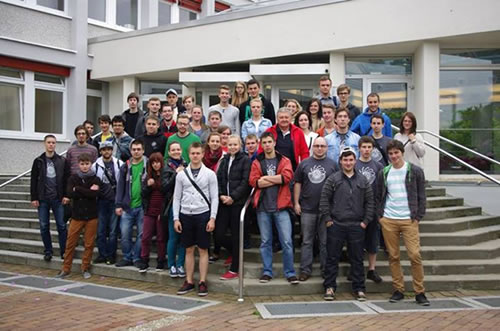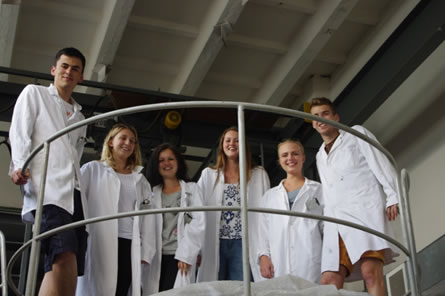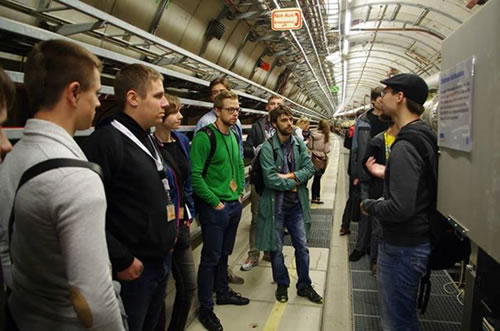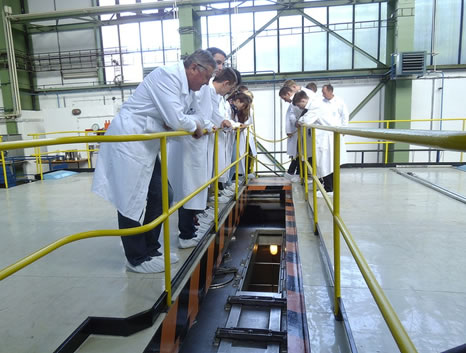
Physics on Wheels
The Physics on Wheels project was launched in order to present to graduates from the Slovak University of Technology the multiple application possibilities of nuclear power and physical engineering. The aim was to demonstrate that the connection between physics and technology can offer something extraordinary to young people and open up possibilities for personal development both at home and abroad. This was already the third time that selected students were able, thanks to the project, to participate in the various lectures and take part in the interesting excursions to our laboratories at the Institute of Nuclear and Physical Engineering and abroad. On this occasion we visited the DESY (Deutsches Elektronen-Synchrotron) physics laboratories and the XFEL (X-ray Free Electron Lasers) laboratory in Hamburg. These laboratories are among the world’s best accelerator centres. We also visited the ÚJV Řež (Centre of Science and Research).

Everything began on 25 May, at 5:30 p.m., at the Faculty of Electrical Engineering and Information Technology, in Bratislava. The participants got together there in order to meet each other and to establish new contacts with other students from different high schools and our faculty.
On 26 May, a series of lectures were given at our faculty under the name: Physics: The dark world. Our teaching staff prepared three interesting presentations entitled: How Higson came to his mass (by Professor Krempaský), Physics between heaven and earth (by Associate Professor Valko) and Electron Accelerators in Slovakia and their application (by Associate Professor Šagátová). All the presentations are available online at: http://147.175.126.50/aktuality-popularizacne_prednasky.php.
In the afternoon, the students received detailed information about study possibilities in the fields of nuclear power and physical engineering at the Institute of Nuclear and Physical Engineering. Afterwards, an exhibition of the work carried out at our laboratories gave students an opportunity to get a glance of the research done at our Institute. Late at night we headed off on the long journey to Hamburg.

On 28 May, we visited the DESY accelerator centre in Hamburg. DESY stands for Deutsches Elektronen-Synchrotron. The research done at this institute is really extensive. Local researchers are investigating the fundamental particles upon which our world is built. They are also interested in research into new materials and new mechanisms for treating sick patients. DESY is one of the largest research centres in Germany. The main objective of the institute is to perform basic research, from which we can obtain new knowledge and learn new approaches in various fields.
The opening presentation set out clearly the main vision of this centre. Subsequently, we had a guided tour of the relevant facilities. We were able to see part of PETRA III, the largest storage-ring in operation, which produces X-ray radiation. Its total length is 2.3 km and the experimental hall itself is 300 m long. All the experiments are performed in this hall. There are 14 beam-lines and 30 metering stations housed in the facility. PETRA III generates X-ray radiation, which is used to examine very small specimens from medicine to nanotechnologies. After visiting the PETRA III experimental hall we went to have a look at the HERA shutdown accelerator. It used to be the largest storage-ring in DESY, and in the whole of Germany too. As the only one of its kind in the world, it was able to accelerate two particle types - protons and electrons, which collided after acceleration. The fact that this accelerator had already been shut down was a great advantage for our excursion, because it provided us with an opportunity to investigate individual accelerator parts, and even to literally touch them. The total tunnel length is 6.3 km and it is placed deep underground. The facility was shutdown in 2007 after 15 years of operation, and the acquired data is still being processed.

On the last day, 30 May, we visited the Řež Research Centre near Prague, where the history of nuclear power in the former Czechoslovakia began. It was necessary to first undergo a personal security check at the entrance, a procedure that is required at all facilities that handle nuclear materials. After a short introduction about the Řež Research Centre we were split into three groups in order to visit the three most interesting places in the area – the LR-0 research reactors, the LVR-15 reactor and the experimental loops. Our tour started with the zero-power LR-0, which serves mainly as an experimental reactor for measuring the neutron-physical characteristics of light water reactors. The original reactor was built in the 1960’s and was based on heavy water. This reactor was necessary for the first KS-150 power reactor in Czechoslovakia, which was under construction at Jaslovské Bohunice site at the time. In the 1980’s it was rebuilt as today’s light-water reactor, satisfying VVER-440 and VVER-1000 needs. Our guide at LR-0 explained all the interesting things that go on in the control room and in the reactor hall. He also described the reactors’ functions, regulation options, and various experiments that are carried out there. Students could see with their own eyes how a detector records natural radiation from the pitchblende ore and how easy it is to shield people from this radiation.
After the LR-0 we moved on to the experimental hall, where two loop systems are located. One system was used for the circulation of supercritical water (SCWL – SuperCritical Water Loop) and the second one was for high-temperature helium circulation (HTHL – High Temperature Helium Loop). A detailed explanation of how these loops work and what kind of experiments are carried out followed. We could observe both systems at close range while passing through to their shared control room. Both loops are related to research into Generation IV nuclear reactors, which are designed to use helium (ALLEGRO, HTR) or super-critical water (SCWR) as the coolant. We learned that the loops are experiencing ‘teething problems’ and that the research there is only just beginning.

The final visit was to the LVR-15 research reactor, which was the first nuclear research reactor in Czechoslovakia. It was inaugurated as a VVR-S reactor in 1957, with a thermal output of 2 MW, and it operated successfully in this state until 1987, when it was rebuilt as the LVR-15 reactor with thermal output of 15 MW. This reactor is used today for materials research, the production of radiopharmaceuticals and other purposes. To enter this reactor was not as easy as it was for the LR-0 visit, where only coats and shoe covers were needed. Instead, if we wanted to enter the LVR-15 we had to pass through a metal detector and all of us had to wear a protective coat, helmet, shoe covers. We also had to carry a personal dosimeter attached to us. With these requirements fulfilled we were able to enter the controlled area. We visited the reactor control room, where we were given a detailed explanation of the functions of the control panels and afterwards moved to the reactor hall. We walked around the reactor deck and saw various experiments that take place in channels that use neutron radiation. The greatest experience for the students was the chance to see Cherenkov radiation with their own eyes in the spent fuel pool. At the end of our visit a final inspection by a whole body detector was necessary to dismiss the possibility of any contamination.
After this final visit we went home to Bratislava. We believe that all participants in the Physics on Wheels Project received new and fascinating information during the one week trip. And we also hope that the visit was a motivation for the students to study more in this technical field and to focus on nuclear energy or physical engineering.
Patrik Novák, Stanislav Pecko, Amine Bouhaddane
The authors are PhD students from Institute of Nuclear and Physical Engineering at Slovak University of Technology, in Bratislava.
|

